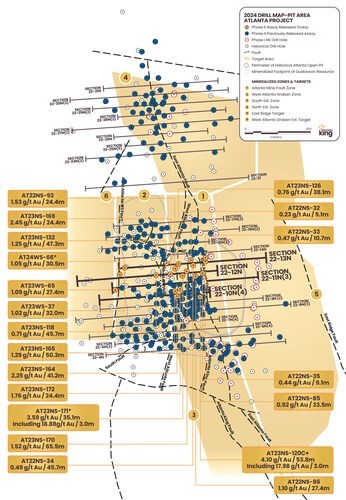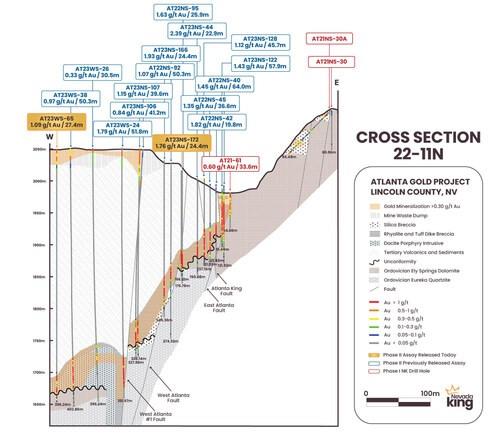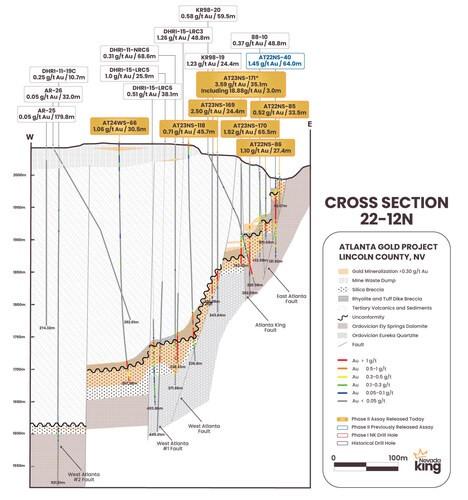
NEVADA KING INTERSECTS 53.8M OF 4.10 G/T AU, 35.1M OF 3.59 G/T AU AND 24.4M OF 1.76 G/T AU WITH 440.6 G/T AG AT ATLANTA

Nevada King Gold Corp. (TSX-V: NKG) (OTC: NKGFF) is pleased to announce assay results from twenty reverse circulation holes and one core hole recently completed at its Atlanta Gold Mine Project located 264km northeast of Las Vegas, Nevada, in the prolific Battle Mountain Trend. Today’s holes are plotted in plan and along sections 22-10N(4), 22-11N(3), 22-12N, and 22-13N, (Figures 1-5).
Highlights:
| Hole No. | From (m) | To (m) | Interval (m) | Au (g/t) | Ag (g/t) | Section |
| AT23NS-120C+ | 15.4 | 69.2 | 53.8 | 4.10 | 32.9 | 10N(4) |
| Including | 60.1 | 63.1 | 3.0 | 17.98 | 63.0 | 10N(4) |
| AT23NS-164 | 149.4 | 190.5 | 41.2 | 2.25 | 100.3 | 10N(4) |
| AT23NS-165 | 155.5 | 205.8 | 50.3 | 1.29 | 108.5 | 10N(4) |
| AT23NS-171* | 118.9 | 154.0 | 35.1 | 3.59 | 37.1 | 12N |
| Including | 138.7 | 141.8 | 3.0 | 18.88 | 48.2 | 12N |
| AT23NS-172 | 123.5 | 147.9 | 24.4 | 1.76 | 440.6 | 12N |
| Table 1. Highlighted holes released today. True thickness of mineralization along the steeply dipping West Atlanta Fault in holes NS-164 and NS-165 is estimated to be 35% to 65% of reported drill intercept length, while true thickness in the other holes is estimated to be 85% to 95% of reported intercept length. *Denotes holes bottoming in mineralization. +Denotes core holes.
|
- Shallow high-grade mineralization (4.10 g/t Au over 53.8m) in core hole AT23NS-120C begins just 15.4m beneath the pit floor along the eastern boundary of the Atlanta Mine Fault Zone and is being used for ongoing Phase II metallurgical test work (Figure 2).
- AT23NS-171 and AT23NS-172 (Figures 3 and 4) were sited to fill in drill gaps along the AMFZ and intersected 3.59 g/t Au over 35.1m and 1.76 g/t Au over 24.4m, respectively. Strong silver values of 440.6 g/t Ag accompany the gold intercept in AT23NS-172. These holes confirm that mineralization is relatively flat-lying across the central portion of the AMFZ, with higher-grade mineralization hosted in silicified rhyolitic intrusions that moved laterally eastward from the West Atlanta Fault along a gently west-dipping erosional unconformity.
- AT23NS-164 (2.25 g/t Au over 41.2m) and AT23NS-165 (1.29 g/t Au over 50.3m) were positioned across a drill gap on the eastern edge of the West Atlanta Graben Zone just west of the WAF. Mineralization is largely hosted within silicified rhyolitic intrusive rock occurring along the hanging wall side of the steeply-dipping WAF, although strongly silicified Paleozoic basement rock beneath the silicified intrusive hosts mineralization as well.
- Both types of strong silicification had previously been lumped into the silica breccia unit, but the Company’s relogging campaign at Atlanta has now shown most of the silica breccia unit to consist of rhyolitic intrusive breccia based on trace element enrichment in chromium coupled with depletion of titanium and magnesium. This is important because these intrusions appear to have played a major role in decalcifying carbonate host rocks and subsequently depositing Au/Ag throughout the Atlanta deposit, which has significant implications as the Company looks for new mineralized zones within the carbonate-dominated regional targets recently identified north and east of the resource zone (released September 17, 2024).
Cal Herron, Exploration Manager of Nevada King, stated, “Drilling completed in and around the Atlanta resource zone continues to inform our understanding behind the genesis of gold deposition at Atlanta. Throughout the West Atlanta Graben Zone and up on the East Ridge Target, we know that rhyolitic intrusions related to gold mineralization show up in the CSAMT data as low resistivity zones. The Company has identified numerous additional CSAMT low resistivity zones scattered throughout the Atlanta district where other such intrusive activity may have occurred.
“Based on our ongoing relogging program, we now recognize that there are two distinct types of intrusive or silica breccia units found at Atlanta – one associated with altered dolomite that rarely hosts gold mineralization outside of the resource zone and the second related to rhyolitic intrusions, which does often host gold mineralization. As the regional drilling begins, this distinction between these two SBX units will play an important role. SBX found to be high in chromium and low in titanium/magnesium will indicate that we are near to a rhyolitic event and with more searching, can reasonably expect to find gold mineralization. On the other hand, SBX encountered with elevated magnesium and low chromium values can be quickly tagged as altered dolomite and disregarded if no anomalous gold is present. Armed with this new exploration model, we feel added confidence in our regional exploration program as we rely on CSAMT signatures, looking for additional (and in many cases larger) intrusive-related mineralized zones.”
| Hole No. | From (m) | To (m) | Interval (m) | Au (g/t) | Ag (g/t) | Section |
| AT23NS-120C+ | 15.4 | 6932 | 53.8 | 4.10 | 32.9 | 10N(4) |
| Including | 60.1 | 63.1 | 3.0 | 17.98 | 63.0 | 10N(4) |
| AT23NS-164 | 149.4 | 190.5 | 41.2 | 2.25 | 100.3 | 10N(4) |
| AT23NS-165 | 155.5 | 205.8 | 50.3 | 1.29 | 108.5 | 10N(4) |
| AT23WS-65 | 355.2 | 382.6 | 27.4 | 1.09 | 16.3 | 11N(3) |
| AT23NS-172 | 123.5 | 147.9 | 24.4 | 1.76 | 440.6 | 11N(3) |
| AT24WS-66* | 336.9 | 367.4 | 30.5 | 1.05 | 17.2 | 12N |
| AT22NS-86 | 61.0 | 88.4 | 27.4 | 1.10 | 22.1 | 12N |
| AT23NS-118 | 265.2 | 311.0 | 45.7 | 0.71 | 9.4 | 12N |
| AT23NS-169 | 178.4 | 202.7 | 24.4 | 2.45 | 55.5 | 12N |
| AT23NS-170 | 91.5 | 157.0 | 65.5 | 1.52 | 44.4 | 12N |
| AT23NS-171* | 118.9 | 154.0 | 35.1 | 3.59 | 37.1 | 12N |
| Including | 138.7 | 141.8 | 3.0 | 18.88 | 48.2 | 12N |
| AT21-18B^ | 0.0 | 4.6 | 6.7 | 0.15 | 22.97 | 13N |
| AT22NS-32 | 112.8 | 122.0 | 9.1 | 0.23 | 8.7 | 13N |
| AT22NS-33 | 35.1 | 45.7 | 10.7 | 0.47 | 118.2 | 13N |
| AT22NS-34 | 86.9 | 132.6 | 45.7 | 0.49 | 41.2 | 13N |
| AT22NS-35 | 27.4 | 36.6 | 9.1 | 0.44 | 44.9 | 13N |
| AT23WS-37 | 336.9 | 368.9 | 32.0 | 1.02 | 9.2 | 13N |
| AT22NS-93 | 176.8 | 201.2 | 24.4 | 1.53 | 24.9 | 13N |
| AT23NS-126 | 161.6 | 199.7 | 38.1 | 0.76 | 20.4 | 13N |
| AT23NS-132 | 189.0 | 236.3 | 47.3 | 1.25 | 30.3 | 13N |
| Table 2. All holes released today. Mineralization along the northerly-trending West Atlanta Fault occurs within an intrusive breccia zone dipping 60 to 70 west, and true mineralized thickness is estimated to be 35% to 65% of reported intercept lengths. Holes along the northerly-trending AMFZ and within the West Atlanta Graben occur within gently dipping silica breccia above the Paleozoic unconformity with true mineralized thickness of 85% to 95% of reported intercept lengths. * Denotes holes bottoming in mineralization. ^ Denotes angle holes. + Denotes core holes.
|
| Hole No. | From (m) | To (m) | Interval (m) | Au (g/t) | Ag (g/t) | Section |
| AT22HG-18 | 257.6 | 291.2 | 33.5 | 2.35 | 363.0 | 10N(4) |
| AT23HG-26* | 279.0 | 317.1 | 38.1 | 0.82 | 27.0 | 10N(4) |
| AT23WS-27 | 193.6 | 256.1 | 62.5 | 1.78 | 3.7 | 10N(4) |
| AT22NS-43A | 3.0 | 30.5 | 27.4 | 1.02 | 21.2 | 10N(4) |
| AT22NS-46 | 4.6 | 59.5 | 54.9 | 3.41 | 26.0 | 10N(4) |
| AT22NS-47 | 64.0 | 89.9 | 25.9 | 2.04 | 27.8 | 10N(4) |
| AT23NS-48 | 91.5 | 112.8 | 21.3 | 1.27 | 35.1 | 10N(4) |
| AT22NS-49 | 62.5 | 88.4 | 25.9 | 3.73 | 46.1 | 10N(4) |
| Including | 67.1 | 74.7 | 7.6 | 6.33 | 28.8 | 10N(4) |
| AT22NS-50 | 89.9 | 108.2 | 18.3 | 3.68 | 27.1 | 10N(4) |
| Including | 93.0 | 99.1 | 6.1 | 7.09 | 33.1 | 10N(4) |
| AT22NS-89* | 172.3 | 213.4 | 41.2 | 0.4 | 67.8 | 10N(4) |
| AT22NS-90 | 182.9 | 222.6 | 39.7 | 0.82 | 52.3 | 10N(4) |
| AT23NS-96 | 105.2 | 135.7 | 30.5 | 0.94 | 51.0 | 10N(4) |
| AT23NS-120 | 33.5 | 71.6 | 38.1 | 1.14 | 43.4 | 10N(4) |
| AT23NS-124 | 12.2 | 86.9 | 74.7 | 2.37 | 43.9 | 10N(4) |
| AT23NS-129 | 109.8 | 143.3 | 33.5 | 1.14 | 31.4 | 10N(4) |
| 90-2 | 135.7 | 173.8 | 38.1 | 0.99 | 90.4 | 10N(4) |
| AR-02 | 182.9 | 205.7 | 22.8 | 1.72 | 46.9 | 10N(4) |
| AR-24 | 36.6 | 38.1 | 1.5 | 0.13 | 5.48 | 10N(4) |
| AT23WS-24 | 324.7 | 376.5 | 51.8 | 1.79 | 21.1 | 11N(3) |
| AT23WS-26 | 306.4 | 336.9 | 30.5 | 0.33 | 3.2 | 11N(3) |
| AT23WS-38 | 327.7 | 378.0 | 50.3 | 0.97 | 5.2 | 11N(3) |
| AT22NS-40 | 15.2 | 79.3 | 64.0 | 1.45 | 32.7 | 11N(3) |
| AT22NS-42 | 61.0 | 80.8 | 19.8 | 1.82 | 31.0 | 11N(3) |
| AT23NS-44 | 100.6 | 123.5 | 22.9 | 2.39 | 48.0 | 11N(3) |
| AT22NS-45 | 70.1 | 106.7 | 36.6 | 1.35 | 35.0 | 11N(3) |
| AT21-61 | 3.0 | 36.6 | 33.6 | 0.60 | 16.7 | 11N(3) |
| AT22NS-92 | 181.4 | 231.7 | 50.3 | 1.07 | 64.0 | 11N(3) |
| AT22NS-95 | 129.6 | 155.5 | 25.9 | 1.63 | 67.3 | 11N(3) |
| AT23NS-106 | 268.3 | 309.5 | 41.2 | 0.84 | 14.1 | 11N(3) |
| AT23NS-107 | 266.8 | 306.4 | 39.6 | 1.15 | 16.4 | 11N(3) |
| AT23NS-122 | 19.8 | 77.7 | 57.9 | 1.43 | 24.0 | 11N(3) |
| AT23NS-128 | 79.3 | 125.0 | 45.7 | 1.12 | 58.8 | 11N(3) |
| AT23NS-166 | 158.5 | 182.9 | 24.4 | 1.93 | 51.3 | 11N(3) |
| DHRI-11-NRC05 | 312.5 | 373.5 | 61.0 | 1.61 | 9.09 | 11N(3) |
| 88-10 | 70.1 | 118.9 | 48.8 | 0.37 | 18.0 | 12N |
| KR98-19 | 192.0 | 216.4 | 24.4 | 1.23 | 44.63 | 12N |
| KR98-20 | 144.8 | 204.3 | 59.5 | 0.58 | 8.92 | 12N |
| DHRI-11-19C+ | 432.8 | 434.3 | 1.5 | 1.09 | 0.10 | 12N |
| DHRI-11-NRC06 | 300.2 | 355.1 | 54.9 | 0.49 | 11.5 | 12N |
| DHRI-15-LRC03* | 289.5 | 338.3 | 48.8 | 1.26 | 5.31 | 12N |
| DHRI-15-LRC05 | 312.4 | 338.3 | 25.9 | 1.0 | 2.47 | 12N |
| DHRI-15-LRC06 | 303.3 | 341.4 | 38.1 | 0.51 | 1.96 | 12N |
| AT22RC-15 | 54.9 | 97.6 | 42.7 | 0.25 | 20.7 | 13N |
| AT21-18A | 4.6 | 50.3 | 45.7 | 0.89 | 65.76 | 13N |
| AT21-19 | 16.8 | 29.0 | 12.2 | 0.11 | <0.5 | 13N |
| AT21-20 | 19.8 | 27.4 | 7.6 | <0.5 | <0.5 | 13N |
| DHRI-11-02C^+ | 86.9 | 105.1 | 18.2 | 0.45 | 85.01 | 13N |
| DHRI-11-21C* | 326.1 | 362.1 | 30.0 | 0.42 | 8.82 | 13N |
| DHRI-15-LRC04 | 297.2 | 339.9 | 42.7 | 0.74 | 2.07 | 13N |
| Table 3. Previously released holes drilled by Nevada King and historic operators. Mineralization along the West Atlanta Fault is estimated to be 35% to 65% of reported intercept lengths, while true thickness in holes along the AMFZ and within the West Atlanta Graben are estimated to be of 85% to 95% of reported intercept lengths. AT series holes drilled by Nevada King in 2021 to 2023. DHRI series holes drilled by Meadow Bay in 2011 and 2015. 90 series holes drilled by Goldfields in 1990. 88 series holes drilled by Bobcat in 1988. *Denotes holes bottoming in mineralization. ^ Denotes angle drill holes. + Denotes core holes. |
QAQC Protocols
All RC samples from the Atlanta Project are split at the drill site and placed in cloth and plastic bags utilizing a nominal 2kg sample weight. CRF standards, blanks, and duplicates are inserted into the sample stream on-site on a one-in-twenty sample basis, meaning all three inserts are included in each 20-sample group. Samples are shipped by a local contractor in large sample shipping crates directly to American Assay Lab in Reno, Nevada, with full custody being maintained at all times. At American Assay Lab, samples were weighed then crushed to 75% passing 2mm and pulverized to 85% passing 75 microns in order to produce a 300g pulverized split. Prepared samples are initially run using a four acid + boric acid digestion process and conventional multi-element ICP-OES analysis. Gold assays are initially run using 30-gram samples by lead fire assay with an OES finish to a 0.003 ppm detection limit, with samples greater than 10 ppm finished gravimetrically. Silver samples that run greater than 100ppm are also finished gravimetrically. Every sample is also run through a cyanide leach for gold with an ICP-OES finish. The QA/QC procedure involves regular submission of Certified Analytical Standards and property-specific duplicates.
Qualified Person
The scientific and technical information in this news release has been reviewed and approved by Calvin R. Herron, P.Geo., who is a Qualified Person as defined by National Instrument 43-101.
About Nevada King Gold Corp.
The Atlanta Mine is a historical gold-silver producer with a NI 43-101 compliant pit-constrained resource of 460,000 oz Au in the measured and indicated category (11.0M tonnes at 1.3 g/t) plus an inferred resource of 142,000 oz Au (5.3M tonnes at 0.83 g/t). See the NI 43-101 Technical Report on Resources titled “Atlanta Property, Lincoln County, NV” with an effective date of October 6, 2020, and a report date of December 22, 2020, as prepared by Gustavson Associates and filed under the Company’s profile on SEDAR+ (www.sedarplus.ca).
| Resource Category | Tonnes
(000s) |
Au Grade (ppm) |
Contained Au Oz |
Ag Grade
(ppm) |
Contained Ag Oz |
| Measured | 4,130 | 1.51 | 200,000 | 14.0 | 1,860,000 |
| Indicated | 6,910 | 1.17 | 260,000 | 10.6 | 2,360,000 |
| Measured + Indicated | 11,000 | 1.30 | 460,000 | 11.9 | 4,220,000 |
| Inferred | 5,310 | 0.83 | 142,000 | 7.3 | 1,240,000 |
| Table 4. NI 43-101 Mineral Resources at the Atlanta Mine | |||||

Figure 1. Location map for holes reported in this news release along the four drill sections 22-10N(4, 22-11(3), 22-12N, and 22-13N relative to the perimeter of the historical Atlanta Pit and footprint of the Gustavson 2020 NI-43101 resource. Shallow drillholes on the mine dumps have been removed from the plot for clarity. (CNW Group/Nevada King Gold Corp.)

Figure 2. Updated cross section 22-10N(4) looking north across the West Atlanta Fault (WAF) that divides the Atlanta Mineralized Fault Zone (AMFZ) target on the east from the West Atlanta Graben Zone (WAGZ) target on the west. Within the AMFZ Au/Ag mineralization is largely hosted within silica breccia horizon along the unconformity of Paleozoic dolomite and quartzite units. Mineralization within the WAGZ is largely hosted within felsic volcanic intrusions above the Paleozoic basement. (CNW Group/Nevada King Gold Corp.)

Figure 3. Updated cross section 22-11N(3) looking north across the Atlanta Mineralized Fault Zone (AMFZ) to the east, and the West Atlanta Graben Zone (WAGZ) to the west. Along the AMFZ Au/Ag mineralization is largely hosted within a silica breccia horizon developed on top of the Paleozoic dolomite and quartzite units along the unconformity, whereas mineralization in the WAGZ is largely hosted within felsic volcanic intrusive along the Paleozoic unconformity. (CNW Group/Nevada King Gold Corp.)

Figure 4. Cross section 22-12N looking north across the Atlanta Mineralized Fault Zone (AMFZ) to the east, and the West Atlanta Graben Zone (WAGZ) to the west. Along the AMFZ Au/Ag mineralization is largely hosted within a silica breccia horizon developed on top of the Paleozoic dolomite and quartzite units along the unconformity, whereas mineralization in the WAGZ is largely hosted within felsic volcanic intrusive along the Paleozoic unconformity. (CNW Group/Nevada King Gold Corp.)

Figure 5. Section 22-13N looking north across the Atlanta Mineralized Fault Zone (AMFZ) to the east, and the West Atlanta Graben Zone (WAGZ) to the west. Along the AMFZ Au/Ag mineralization is largely hosted within a silica breccia horizon developed on top of the Paleozoic dolomite and quartzite units along the unconformity, whereas mineralization in the WAGZ is largely hosted within felsic volcanic intrusive along the Paleozoic unconformity. (CNW Group/Nevada King Gold Corp.)
MORE or "UNCATEGORIZED"
Kuya Silver Confirms High-Grade Silver-Gold Vein Mineralization at Umm-Hadid with Initial Drill Results up to 1483.9 g/t AgEq over 2 Metres
Kuya Silver Corporation (CSE: KUYA) (OTCQB: KUYAF) (FSE: 6MR1) is... READ MORE
First Phosphate Closes Final Tranche of Oversubscribed Private Placement
First Phosphate Corp. (CSE: PHOS) (OTCQX: FRSPF) (FSE: KD0) is... READ MORE
GFG Receives Final Payment from the Sale of its Rattlesnake Hills Gold Project
GFG Resources Inc. (TSX-V: GFG) (OTCQB: GFGSF) announces that i... READ MORE
Goliath Receives $1,730,882 Through Warrant Exercises, Inclusive Of Crescat Capital A Longtime Strategic And Cornerstone Shareholder
Goliath Resources Limited (TSX-V: GOT) (OTCQB: GOTRF) (FSE: B4IF)... READ MORE
Robex Pours First Gold at Kiniéro on Schedule and Budget
Highlights: Gold bar weighing 2.64 kilograms (85 oz) poured in th... READ MORE












